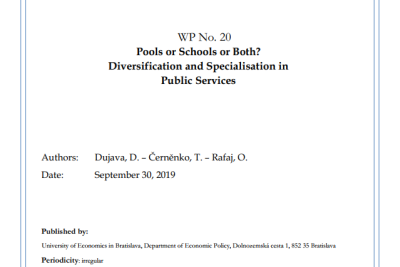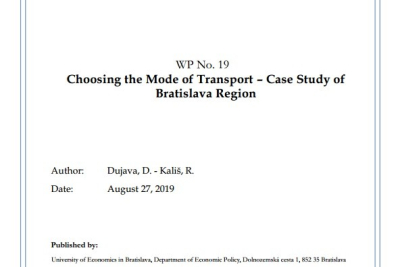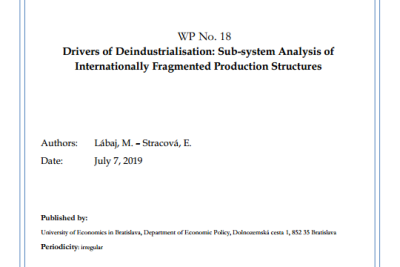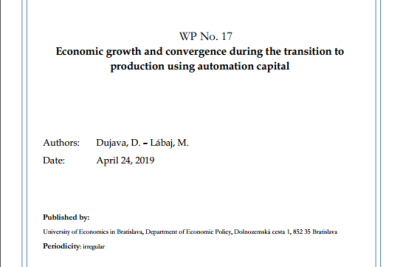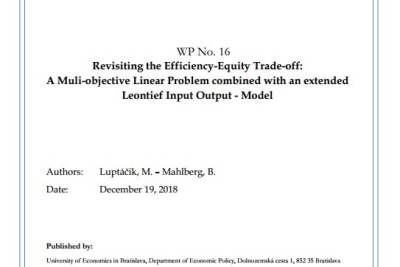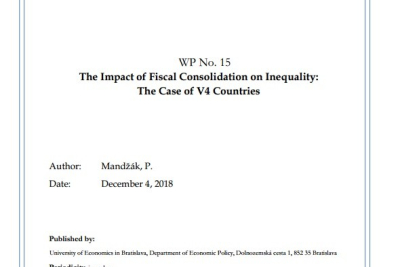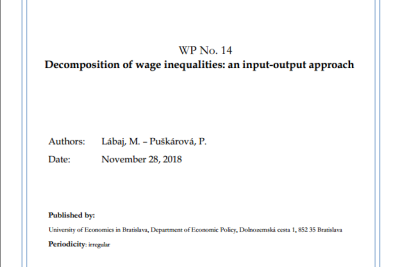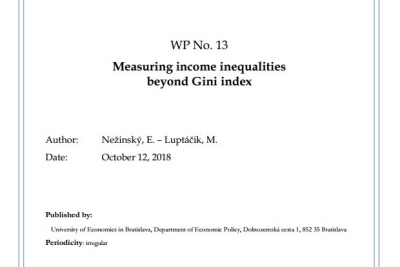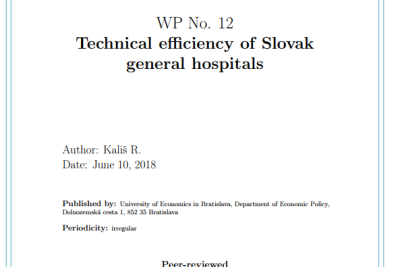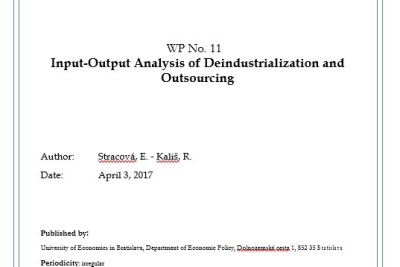Abstract
We develop a model of two municipalities providing two public services. We show that in case of intermediate level of transferability of public services between two municipalities, Pareto-suboptimal Nash equilibrium exists. In this case, cooperation between municipalities or merging of two municipalities into one unit would improve welfare.
Abstract
We analyse commuting patterns in Bratislava’s fast growing sub-urban region with suboptimal developed infrastructure. Standardized discrete choice model is used to estimate demand for individual car transport as well as for public buses and trains and to obtain corresponding elasticities with respect to travel costs, times and income. We find low rate of substitution between available modes. Direct price elasticity for public modes is in accordance with often cited rule of thumb -0.3. Negative income elasticities of demand for buses and trains, together with low direct price elasticity for car transport can be hard to overcome when looking for solution of current traffic problems in the region. We use modelled demand to predict effects of two recently proposed policies - new parking system in Bratislava city and construction of highway D4R7. In case of first policy, we expect massive reduction in car usage due to increased costs for car commuters. On the other hand, new highway would have only limited impact on mode choice and could reduce number of train commuters.
Abstract
This paper deals with the drivers of deindustrialisation in major developed countries over the last two decades. In contrast to some recent studies, we show that the importance of manufacturing for the world economy has not declined during the examined period. We argue that the observed deindustrialisation measured by direct employment and value-added shares of manufacturing underestimates the importance of manufacturing. Many former in-house activities of manufacturing are nowadays outsourced to other industries and are not accounted for in the direct statistics. We show that at least in major developed countries the level of outsourcing reached its limits at the beginning of the new millennium. At the same time, the offshoring of activities interlinked with manufacturing became the dominant driver of deindustrialisation in these countries. We are the first to study the importance of manufacturing from a truly global perspective and we use final consumption expenditures approach that allows us to consistently analyse the role of i) outsourcing, ii) offshoring and iii) changes in final demand, in its development.
Abstract
This paper examines the implications of automation capital in a Solow growth model with two types of labour. We study the transition from standard production to production using automation capital which substitutes low-skilled workers. We assume that despite advances in technology, AI and machine learning, certain tasks can be performed only by high-skilled labour and are not automatable. We show that under these assumptions, automation capital does not generate endogenous growth without technological progress. However, assuming presence of technological progress augmenting both effective number of workers and effective number of industrial robots, automation increases rate of long-run growth. We analyse a situation in which some countries do not use robots at all and other group of countries starts the transition to the economy where industrial robots replace low-skilled labour. We show that this has potential non-linear effects on σ-convergence and that the model is consistent with temporary divergence of incomes per capita. We derive a set of estimable equations that allows us to test the hypotheses in a Mankiw-Romer-Weil framework.
Abstract
In recent years there has been increasing interest in the question of how inequality affects economic growth. This growing interest has recently stimulated new theoretical as well as empirical research. Some existing theoretical models propose income inequality is detrimental to growth, but alternative theoretical models point at inequality as a determinant furthering economic growth. The main goal of this paper is to obtain deeper insights into the so-called efficiency-equity trade-off. Recently the Stiglitz-Report (Stiglitz et al., 2010) revealed several limits of GDP as an indicator of economic performance and social progress and recommended to shift emphasis towards measuring people's well-being. Following this recommendation, we develop a new multiple criteria decision making model coupled with an extended Leontief input-output model taking into account the social dimension and obtain deeper insights into the so-called efficiency-equity trade-off.
Abstract
The aim of this paper is to provide the first empirical evidence of the impact of fiscal consolidation on income inequality in V4 countries. Although the literature on income inequality and its various determinants is wide, there are still some areas in this topic, where the research is lacking. Different specifications of models imply that fiscal consolidation in V4 countries leads to an increase in income inequality. Results of our analysis suggest, that fiscal consolidation larger than 2 % of GDP has negative impact on equality in V4 countries, while this effect is stronger than the effects of our control variables { GDP growth, change in total factor productivity (TFP), change in trade openness, mean years of schooling and unemployment. Change in structural balance seems to have no effect on income inequality in the given countries. However, structural balance have surprisingly negative effect. We believe it is due to the structure of our data set, which contains only three observations with positive structural balance.
Abstract
Income and wealth inequalities, both between and within the advanced and developing countries, have attracted much attention in current economic debates. Wage inequalities appear to play a key role in the generation of final inequalities in terms of households’ income, consumption and wealth. In this paper, we propose a decomposition approach based on the input-output analysis that allows us to disentangle the effects on the final inequalities’ levels into the contributions of various determinants. So far, the analysis of income and wealth inequalities measured by standard inequality indices, e.g. Gini coefficient, Theil index, has received limited space in the input-output analysis. This does not imply that issues of income and wealth inequalities have been ignored in this stream of research. The focus of the input-output research has however been directed into distinct aspects of inequalities. In one way, researchers have put a lot of effort in the understanding how the income and wealth inequalities influence the structure of final demand of households, and eventually generate ambivalent effects on production, value added and employment. Other stream of research in input-output analysis has paid a lot of attention to inequalities that arise from the distribution of income that goes to labour and capital. We propose to calculate cross-industry and cross-country wage inequalities directly from the input-output tables and analyse the final inequality variations through the lens of changes in the inputs. Detailed industry-level data on employees’ wages linked to their hours worked and education attainments, which are covered by the World input-output database, allow us to illustrate the application of proposed methodology on major advanced and developing countries in the world. The analysis contributes to solving the puzzle around the impacts of human capital and technological progress on income inequality but may shed also more light on the rising global inequalities unfolded by international trade and fragmentation of global value chains.
Abstract
Growing interest in the analysis of interrelationships between income distribution and economic growth has recently stimulated new theoretical as well as empirical research. Since existing theoretical models propose inequality is detrimental to growth, while others point at income inequality as an essential determinant supporting economic growth. Measures such as head-count ratio for poverty index or widely used Gini coefficient are aggregated indicators without deeper insight into income distribution among the poor or the households. To derive an indicator accounting for income distribution among the income groups, we propose output oriented DEA model with inputs equal unit and weights restrictions imposed so as to favour higher income share in lower quantiles. We demonstrate the merit of this approach on the quintile income breakdown data of the European countries. Prioritizing lower income groups´ welfare, countries – e.g. Slovenia and Slovakia – can be equally favoured by the new proposed indicator while assessed differently by Gini index. Intertemporal analysis reveals a slight deterioration of income distribution over the period of 2007 – 2017 in a Rawlsian sense.
Abstract
In this study, technical efficiency of Slovak general hospitals was investigated. The well-known non-parametric Data Envelopment Analysis was used to compare performance of Slovak health care providers. Results are based on four slightly differentiated models. Both CRS and VRS variation with different input approaches were used. Our results suggest low average efficiency in Slovak hospitals in the range 0.45 to 0.62 with great variations in efficiency score between individual Decision Making Units (DMUs). These results are relative without appropriate cross-country comparisons. Furthermore, in type of hospital entity there is no significant difference in efficiency score. However there is not a single efficient DMU in a group of municipality hospitals. Although, these results must be taken with caution due to questionable quality of data, this paper provides some valuable overview on technical efficiency of health care providers.
Abstract
The paper deals with the topic of deindustrialization as a process of a decreasing relative importance of manufacturing. While the decrease of manufacturing in major developed and developed economies is undeniable, the developing and newly industrialized economies are starting to experience this phenomenon as well. The results of the paper show that the so-called premature deindustrialization is mainly caused by outsourcing. Furthermore, the data suggest the existence of an upper limit of outsourcing for major developed economies. In these economies, the decrease of manufacturing is more likely caused by other relevant factors. Last but not least, a few transition economies face to a slightly decreasing value of outsourcing on a much lower level. This could be explained by a fragmentation of the entire value chain across the European Union. The empirical results are based on the Input-Output methodology, the observation period of fifteen years from 2000 to 2014 and a sample of 43 countries.
Strategický partner
Hlavní partneri
Partneri

